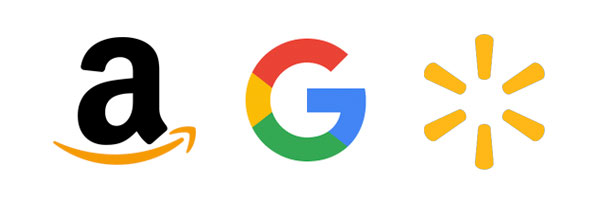The big three marketplaces are duking it out on the Internet for market share and consumer dollars. Amazon Prime, Google, or Walmart – which one is the best? Let’s take a closer look!
User Experience/Product Offerings
Amazon Prime is a subscription-based program. Customers can shop from a computer, mobile device via the Amazon app or through Amazon’s voice assistant, Alexa. Amazon offers a huge selection of products ranging from apparel, books, sporting goods, tech items, etc. In addition to purchasing products, Prime members can stream entertainment content: TV shows, movies, and Amazon original programming.
Amazon Prime Now is a separate program available to Amazon Prime members that offer groceries from Whole Foods, as well as household items and essentials. Shoppers can place orders for free same-day delivery in select zip codes.
Google offers a multi-layered shopping experience, where consumers can purchase items across multiple Google platforms like Google Search, Google Assistant (voice-activated Google Home), YouTube, and the Google Express mobile app. Unlike Amazon, there is no annual membership fee.
Shopping on Google Express is simple and easy. Customers can purchase products from multiple retailers in one quick transaction with the use of a universal shopping cart and stored credit card information.
Walmart, known for it’s brick and mortar presence, has moved aggressively into online retail. Through Walmart’s incredible advertising, it has positioned itself as a power player in the marketplace.
Shipping Delivery
Google Shopping Actions provides same-day, overnight or two-day delivery from a variety of stores. Your delivery date availability depends on the retailer and where you live because delivery to certain zip codes might receive orders by the end of the day or take several days.
As part of their membership, Amazon Prime users receive free two-day shipping. In a bold move, Amazon announced earlier this year that it would transition to a one-day delivery service for Prime members.
Not to be outdone, Walmart rolled out a one-day delivery service, called NextDay. One-day shipping service is free as long as you spend a minimum of $35. NextDay is currently active in key US markets, with expansion expected to cover most of the United States by the end of 2019.
Who Is the Winner of the Battle?
Did you know that over 55% of all product searches originate on Amazon and that 92% of users who start on Amazon, end up purchasing on Amazon? Clearly, Amazon has captured a large market share, but other marketplaces are rising to the challenge. One example is Instagram Shopping, which is in its infancy stage as a marketplace. Known primarily as a photo-sharing app, Instagram is quickly evolving into a contender, especially among millennials.
What Does It Mean for Retailers?
These online marketplaces represent an opportunity for merchants to get their products listed everywhere. Managing hundreds, thousands, and even millions of product listings across multiple marketplaces can be a challenge. Having an intelligent feed management platform that can optimize product listings and automate order fulfillment may just be the solution!
About the Author
 Brian Roizen is the Cofounder and Chief Architect of Feedonomics, a full-service feed optimization platform that optimizes product data for hundreds of channels. He has been featured on numerous podcasts and webinars, and regularly contributes to Search Engine Land and other industry-leading blogs. Brian graduated summa cum laude from UCLA with both a bachelor’s and master’s degree in Mechanical Engineering.
Brian Roizen is the Cofounder and Chief Architect of Feedonomics, a full-service feed optimization platform that optimizes product data for hundreds of channels. He has been featured on numerous podcasts and webinars, and regularly contributes to Search Engine Land and other industry-leading blogs. Brian graduated summa cum laude from UCLA with both a bachelor’s and master’s degree in Mechanical Engineering.


